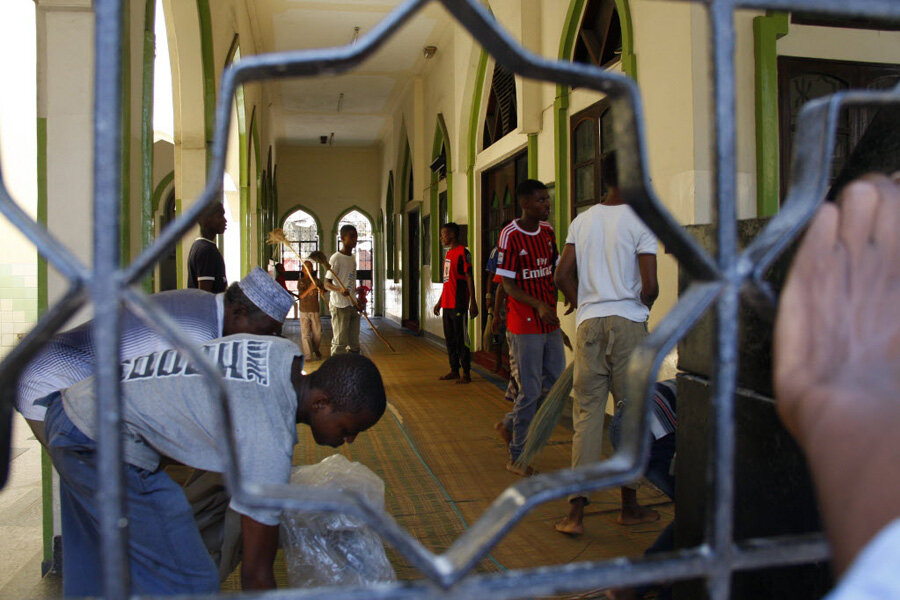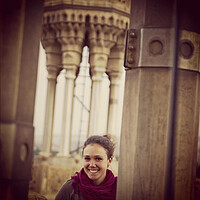Fighting extremism in coastal Kenya: a mosque rebounds
Loading...
| Mombasa, Kenya
Musa Mosque reclaimed its name on Friday, declaring it was back on track after an eight-month takeover by radical Islamic youth who have surged in number amid increasing extremism along Kenya's coast.
The building, renamed "Martyr's Mosque" by the youth who overran it, became a symbol last year of Mombasa’s struggle to contain growing extremism among its young men.
The professional sign hung by the steward Khatib Khamis, recognizing the mosque’s founder, Musa, was seen by many in the Majengo neighborhood as a victory lap. But it will take a lot more than a sign to shake off the mosque's reputation as a haven for extremists and to ensure that other mosques in the port city don’t go through the same cycle.
“That mosque is a symbol, a manifestation of the problems of the youth,” says Muhdar Khittany, the provincial chairman for the Supreme Council of Kenya Muslims. “It’s just a matter of time before it happens again.”
The young men of Mombasa, a city with a 41 percent Muslim population, face rampant unemployment, school dropout rates, and drug addiction, all of which make them easy recruitment targets for extremists like the Somali-based militant group Al Shabab. The community has taken steps to try and raise awareness, but the underlying issues will take years – and government intervention – to address.
Tensions have built since Kenya's military joined African Union forces fighting in Somalia in 2011. President Uhuru Kenyatta has called on Kenyans to help combat terrorism by informing authorities about potential militant activity in their community.
Police ran the radical youth out of the mosque in November, but their heavy-handed tactics, including the temporary closure of the mosque and the arrest of hundreds of young men, enraged the coastal Muslim community. Organizations like Muslim for Human Rights slammed their tactics as encouraging further radicalization.
Weeks after the mosque was reclaimed from the youth, government officials returned it to local residents in a ceremony that drew hundreds from across Mombasa. Attendees cleaned and prayed joyfully that afternoon, packed in tightly to make room for all the newcomers there to show their support.
Two months later, it is making a slow recovery. The imam today is Salim Fuad, an 18-year-old who leads prayer while he waits for his high school exam results so he can apply to university. The mosque’s financial backer, who suspended his assistance when the youth took over, is waiting to see if the peace that has settled in the neighborhood will last before releasing money again.
"It's suffering, but recovering," says Mr. Khamis, the steward. "When [the radicals] took over, we had only one line or two lines of people praying. Now we have six to eight lines every prayer."
The bustle has returned to the busy downtown area that was eerily empty in November, but the normalcy is ensured by a heavy plainclothes police presence. Members of the Council of Imams and Preachers of Kenya, an umbrella organization for Islamic leaders, are still afraid to come to Musa, Khamis says. Their former leader, Sheikh Mohamed Idris, was gunned down in Mombasa in June 2014.
“[The youth] said they want to kill them all,” he says.
Khamis and Mr. Fuad, the imam, have no fear that young radicals will come back to Musa, which they say is surrounded undercover government agents. But that doesn’t mean the seething has been stamped out – just suppressed.
A young shopkeeper around the corner from Musa, who declined to be named, said angrily that Khamis, whose stewardship of the mosque was approved by government officials, was not the rightful leader.
“The problem is still there. The youth, they don’t have work to do,” Khamis says, noting that many young people in Majengo supported those who took over Musa and still live in the neighborhood. It’s unclear what would happen if the heavy police presence was lifted.
“With time [Musa] will be back. We just need peace,” says Fuad.
The Ford Foundation supported Ariel Zirulnick's reporting from Mombasa, Kenya.






